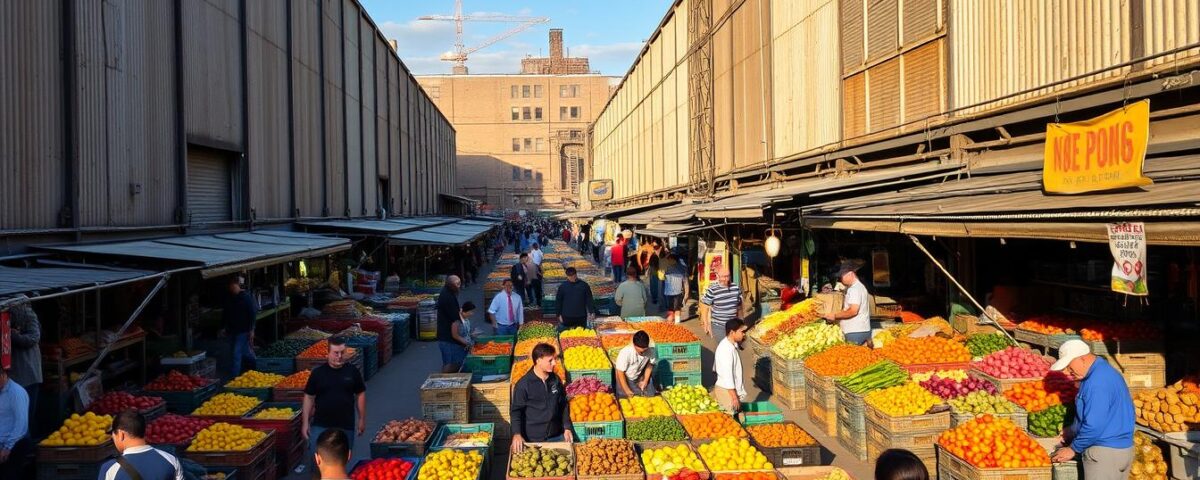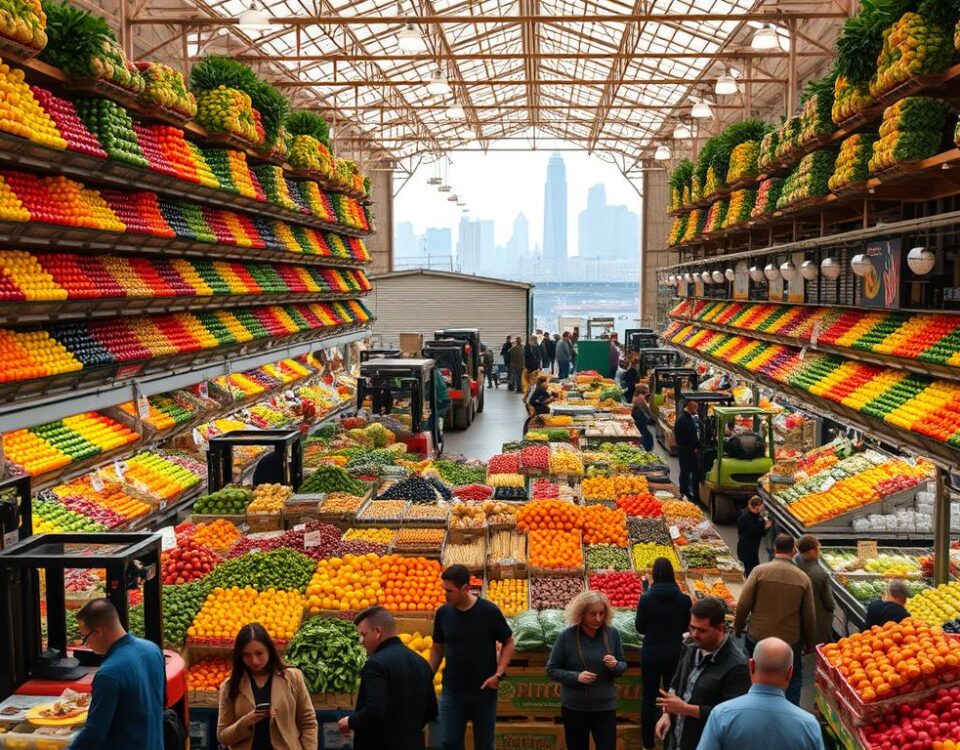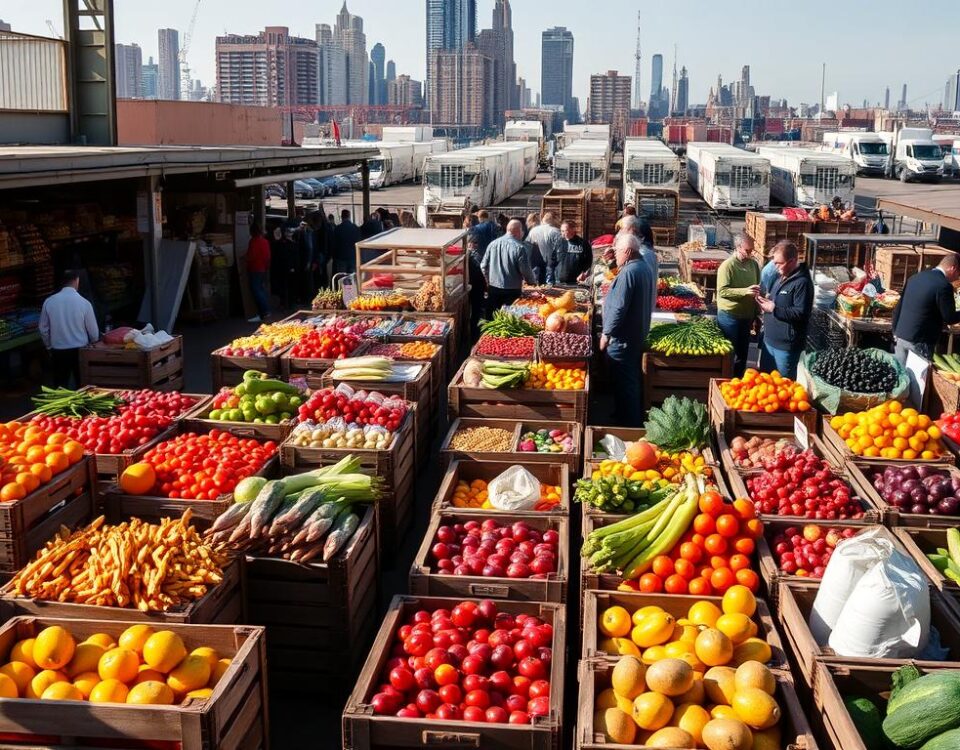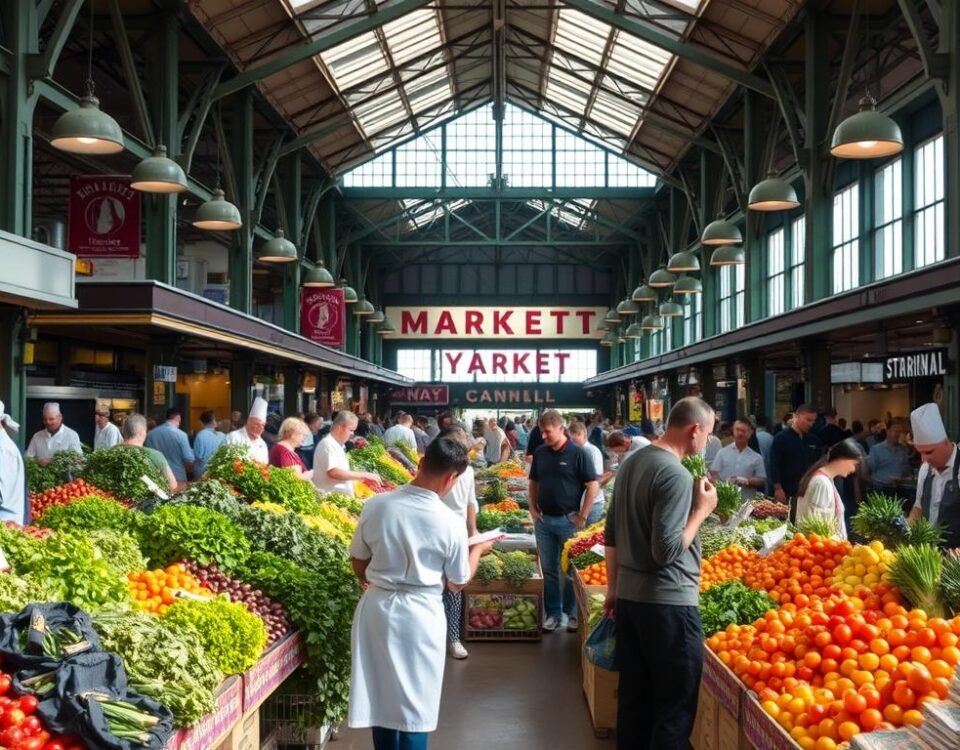
How to Cut Produce Costs 20 % with NYC Wholesale Markets
August 18, 2025Navigating the vast aisles of the Hunts Point Terminal Market can be a daunting task, but with years of experience, I’ve learned the secrets to scoring incredible deals on fresh produce, seafood, and meat.
This massive food distribution center in the Bronx handles over 4.5 billion pounds of food annually, making it a crucial hub for businesses and individuals alike. As the largest of its kind in the world, it offers unparalleled access to wholesale prices that can significantly reduce your food costs.
Whether you’re a restaurant owner or an ambitious home cook, this guide will help you navigate the 60-acre marketplace like a pro. With my insider knowledge, you’ll be able to secure the freshest products at the best prices.
Key Takeaways
- Discover the best times to visit the market to score deals
- Learn proven negotiation techniques to secure the freshest products
- Understand the access requirements and necessary documentation
- Explore the various sections of the market and their offerings
- Build relationships with vendors and merchants to get the best deals
Understanding the Hunts Point Terminal Market Guide
With its vast array of products and bustling atmosphere, Hunts Point Terminal Market is a hub for food distribution that demands a closer look. As I navigate through the market, I’m struck by its complexity and the opportunities it presents for those looking to source high-quality products.
What Makes Hunts Point the Largest Food Distribution Center
Hunts Point Terminal Market stands out as the largest food distribution center due to its unparalleled diversity of products and its ability to cater to a wide range of foodservice needs. The market’s strategic location and state-of-the-art facilities make it an ideal hub for the distribution of fresh produce, seafood, and meats. For more information on how to make the most of your visit, you can explore resources available on Delivisor, a platform that can help streamline your food distribution process.
| Section | Products | Key Features |
|---|---|---|
| Produce Market | Fresh fruits and vegetables | Diverse selection, local and international growers |
| Seafood Market | Fresh and frozen seafood | Rare and exotic options for specialized cuisines |
| Meat Market | High-quality meats | Beef, pork, poultry, and specialty meats at wholesale prices |
The Three Main Sections: Produce, Seafood, and Meat
The Hunts Point Terminal Market is divided into three main sections, each catering to different needs within the food distribution industry. The Produce Market is the largest section, featuring a vast array of fresh fruits and vegetables sourced from both local and international growers. The Seafood Market offers an incredible variety of fresh and frozen seafood, including rare and exotic options. Meanwhile, the Meat Market provides high-quality meats ranging from beef and pork to poultry, catering to a variety of foodservice needs.
Understanding the distinct layout and operations of these sections is crucial for first-time visitors. Each section operates with slightly different rules and hours, and being aware of these differences can help you plan your visit more effectively. For instance, the Produce Market is particularly lively in the early morning hours when restaurants and retailers are stocking up for the day.
Preparing for Your Visit: Access Requirements and Logistics
Before you head to the Hunts Point Terminal Market, it’s essential to understand the access requirements and logistics. As someone who has navigated this market multiple times, I can attest that being prepared makes all the difference in having a successful and stress-free visit.
Who Can Shop at Hunts Point Terminal Market
The Hunts Point Terminal Market is not open to the general public. Access is restricted to business owners and licensed professionals who can provide the necessary documentation. This includes restaurant owners, caterers, and other food service professionals. To gain access, one must apply for a buyer’s license, which involves providing business registration documents and other relevant information.
Business Documentation and Payment Methods
When visiting the market, it’s crucial to have the right documentation and payment methods. Most vendors require a buyer’s license, and some may also ask for additional identification. It’s also a good idea to have a credit line or sufficient funds for your purchases, as many vendors accept major credit cards and other digital payment methods.
| Payment Method | Accepted By | Notes |
|---|---|---|
| Major Credit Cards | Most Vendors | Visa, Mastercard, Amex |
| Digital Payments | Many Vendors | Apple Pay, Google Pay |
| Cash | Some Vendors | Preferably with exact change |
Market Hours and Best Times to Visit
The Hunts Point Terminal Market operates from Sunday at 9 p.m. to Friday at 3 p.m. The best time to visit is early morning, between 2 a.m. and 6 a.m., when vendors have the freshest supplies and crowds are smaller. Avoiding peak hours (7 a.m. to 10 a.m.) can help you avoid congestion and longer wait times.
- Early morning visits (2 a.m. to 6 a.m.) offer the freshest selection and smaller crowds.
- Afternoon visits may yield deals as vendors discount items they need to move.
- For a balance between selection and crowd levels, consider a weekday morning around 6 a.m.
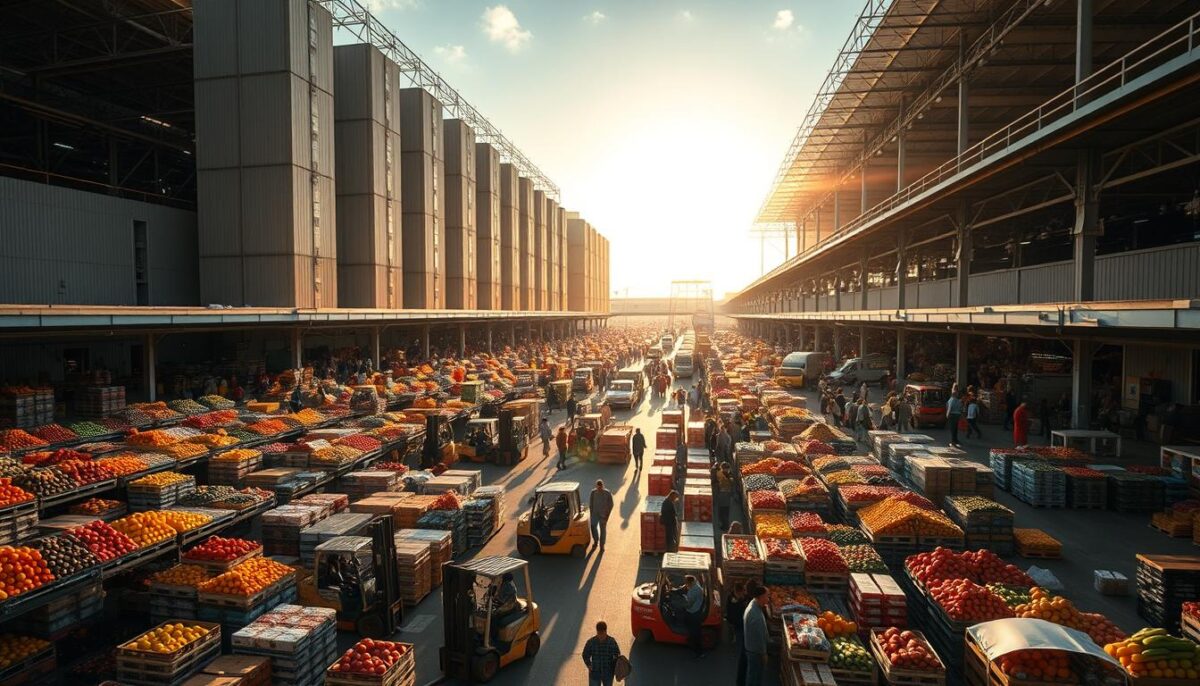
Navigating the Market Like a Pro
Navigating the Hunts Point Terminal Market requires a combination of preparation, knowledge, and flexibility. As one of the largest food distribution centers in the world, the market can be overwhelming, but with the right approach, it can be a valuable resource for businesses.
Understanding the Market Layout and Platforms
The Hunts Point Terminal Market is divided into three main sections: produce, seafood, and meat. Understanding the layout is crucial for efficient navigation. The market is located at 772 Edgewater Road in the Bronx, New York, and its expansive area is home to over 160 merchants.
Key Merchants and Their Specialties
The market is home to a diverse range of merchants, each with their specialties. Some notable vendors include those who specialize in exotic fruits, artisanal cheeses, and premium meats. Building relationships with these merchants can lead to better deals and more personalized service.
| Merchant Type | Specialty |
|---|---|
| Produce | Exotic Fruits, Organic Vegetables |
| Seafood | Fresh Catch, Sustainable Seafood |
| Meat | Premium Cuts, Grass-Fed Beef |
Transportation and Parking Tips
Transportation to and from the market is a critical consideration. The type of vehicle you bring impacts both your entrance fee and your ability to transport purchases. For instance, the entrance fee for a car is $2, while vans or pickup trucks are $5. For frequent visitors, an Entrance ID Card & Car Decal is available for a yearly fee of $120, granting access to the fast lane.
- Plan your transportation carefully, considering the type of vehicle and its impact on entrance fees.
- Allow extra time when visiting during peak hours (5-8 a.m.) due to potential congestion at the market entrance.
- For large purchases, bring proper storage equipment like coolers or refrigerated transport to maintain product quality.
By understanding the market layout, knowing key merchants, and planning your transportation, you can navigate the Hunts Point Terminal Market like a pro, making the most of your time and access to this vast distribution center.
Insider Strategies for Scoring the Best Deals
The key to unlocking the best deals at Hunts Point lies in understanding the market’s dynamics and being prepared to negotiate. As the largest food distribution center in the New York City area, Hunts Point Terminal Market offers a vast array of fresh produce, seafood, and meat, making it a prime destination for businesses looking to source high-quality products.
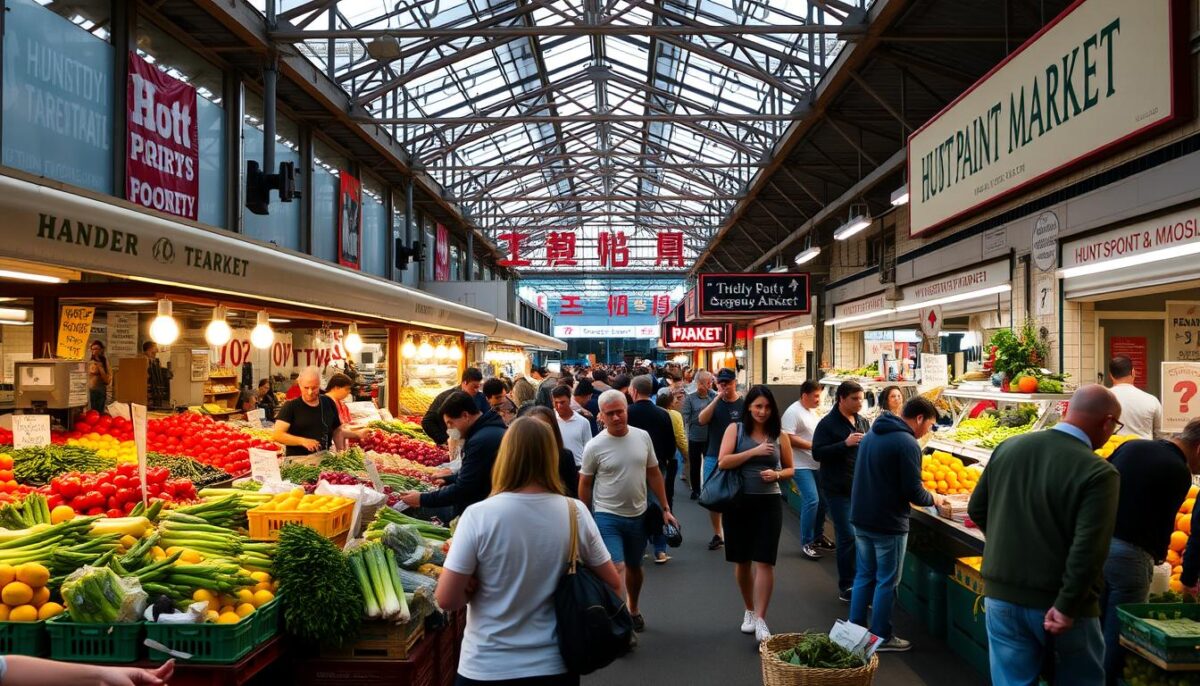
Building Relationships with Vendors
Building strong relationships with vendors is crucial for getting the best deals. By establishing a rapport with the sellers, you can gain access to better prices, priority service, and even exclusive offers. It’s not just about making a purchase; it’s about creating a mutually beneficial partnership.
Comparing offerings between vendors can lead to better deals. Prices and quality can vary widely between vendors, so don’t hesitate to shop around before making a purchase, especially for high-volume orders.
Seasonal Buying Strategies
Understanding the seasonal availability of products can help you make more informed purchasing decisions. By buying in season, you can take advantage of lower prices and fresher produce. It’s also essential to stay up-to-date with market trends and adjust your buying strategy accordingly.
Negotiation Techniques That Work
Negotiation is an art that requires a combination of confidence, respect, and strategy. I’ve refined my negotiation approach at Hunts Point over the years, finding that respectful but confident price discussions are much more effective than aggressive haggling.
- One technique that consistently works for me is bundling purchases—when I’m buying multiple items from the same vendor, I politely ask if they can offer a better overall price for the complete order.
- Timing my negotiations strategically works wonders—late in the day or toward the end of the week, vendors are often more willing to negotiate on perishable items they don’t want to hold over.
- For large-volume purchases, I always discuss pricing directly with the manager or owner rather than staff, as they typically have more authority to offer meaningful discounts.
- I make it a practice to know current market prices before negotiating, which gives me credibility and prevents me from making unreasonable offers that might damage vendor relationships.
Conclusion: Making the Most of Your Hunts Point Experience
My experiences at Hunts Point have shown me that it’s more than just a market – it’s a vital part of New York City’s culinary landscape. The Hunts Point Terminal Market is a cornerstone of the food supply chain in the Northeast, handling over 4.5 billion pounds of food annually.
As a frequent visitor, I can attest that the extra effort to shop here is well worth it for the unmatched selection, quality, and wholesale pricing. Whether you’re a restaurant owner or a serious home cook, Hunts Point offers an authentic food sourcing experience that connects you directly to the global food distribution network.
To make the most of your visit, come with a specific shopping list, arrive early, and be prepared to navigate a bustling marketplace. As you develop your routine and build relationships with vendors, each visit will become easier and more rewarding. With its convenience and vast offerings, Hunts Point Terminal Market is an essential destination for anyone looking to elevate their food game in the heart of New York City.
FAQ
What are the operating hours of the Hunts Produce?
The produce section is open from 2am to 6pm, Monday through Saturday. I recommend visiting during the early morning hours for the freshest selection.
Can individuals purchase from the meat and seafood vendors?
Yes, both individuals and businesses can buy from the meat and seafood vendors. However, some vendors may have minimum purchase requirements, so it’s best to call ahead and confirm.
How do I get to the food distribution center?
The food distribution center is easily accessible by car, taxi, or ride-hailing services. There are also public transportation options available, including buses that stop nearby.
What forms of payment are accepted by the vendors?
Most vendors accept cash, credit cards, and checks. I recommend having some cash on hand, as some smaller vendors may not accept credit cards.
Are there any regional food options available at the cooperative?
Yes, the cooperative features a diverse range of regional food options, including produce, meats, and seafood from local farms and suppliers.
Can I negotiate prices with the vendors?
Yes, many vendors are open to negotiating prices, especially for large or bulk purchases. I recommend building a relationship with the vendors to get the best deals.
Is there parking available at the food distribution center?
Yes, there are several parking lots and garages near the food distribution center. I recommend arriving early to secure a spot.
What is the quality control process for the products sold at the cooperative?
The cooperative has a rigorous quality control process in place to ensure that all products meet high standards of freshness and quality.
